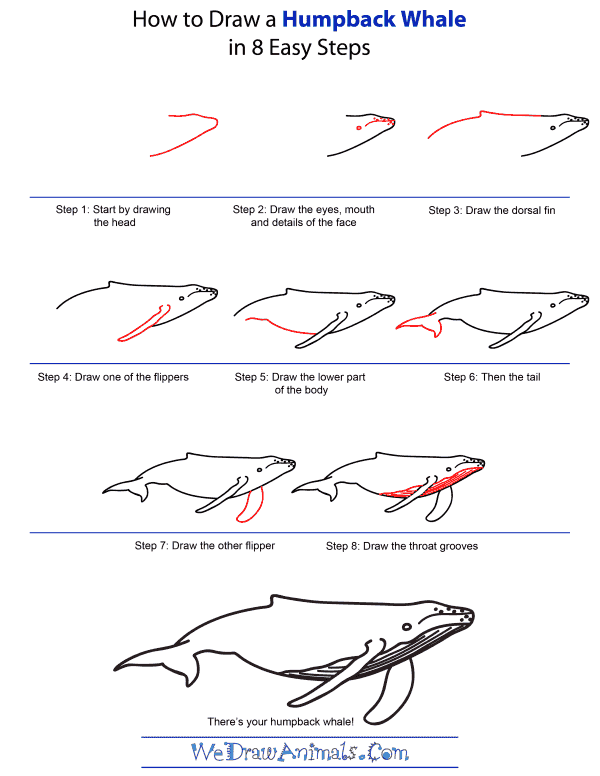In this quick tutorial you'll learn how to draw a Humpback Whale in 8 easy steps - great for kids and novice artists.
The images above represent how your finished drawing is going to look and the steps involved.
Below are the individual steps - you can click on each one for a High Resolution printable PDF version.
At the bottom you can read some interesting facts about the Humpback Whale.
Make sure you also check out any of the hundreds of drawing tutorials grouped by category.
How to Draw a Humpback Whale - Step-by-Step Tutorial
Step 1: The Humpback whale can be drawn in 8 steps. The first is to make the head, by making two sides of a bumpy triangle. The top side should have a hump in the middle, before taking a curving corner towards a smooth, round chin for the whale.
Step 2: Now add the mouth, eyes, and little dots on its lips. The mouth can be added by a simple curving line that goes back and down. The eye should be a small circle just behind the mouth. Make sure to make the dots on his mouth very small!
Step 3: Next we draw the back. It should be a line that goes back from the top of its head, curving up very slightly, before coming to a top, fin-like hump. It should curve forward and down only a little bit. After that, make a curving line that goes towards its back and down again.
Step 4: Now for the first flipper! It should be made with two curving lines that start just behind the eye, and curve down and back. The curving lines should meet with a short connecting line at their ends.
Step 5: We can draw the belly by making a curved line that goes back, and up slightly at first. When you're nearing the back, curve it down, and to the back. Leave space between the back and belly so you can add the tail next!
Step 6: The tail can be drawn with four lines. The first starts from just below the back, slanting back and ending in a slight downward curve. The next short line curves up and towards the front at first, before leveling out. The next line is short as well, slanting towards the front and down, before curving almost straight down. The last is a simple curving shape that connects your third line with the belly.
Step 7: Next add the second flipper. It should be a big paddle shape that curves back slightly, and has a broad, round tip.
Step 8: Humpback whales have grooves on their chin, throat and belly! These are long stripes that run down its body. Draw these in by making many lines that are next to each other! Now you have drawn your whale!
Interesting Facts about the Humpback Whale
Humpback whales live all regions of the oceans. They are well-known for their “singing.”
Did You Know?
- Humpback whales usually eat krill, mackerel, salmon, and small fish.
- Humpback whales use a technique called bubble net fishing when they are hunting for food. A group of humpback whiles encircle the fish and produce bubbles and sounds. The fish, in turn, become scared and easy to catch.
- Adult humpback whales are 40 to 60 feet long, and they weigh as much as 79,000 pounds.
- Humpback whales do not have teeth. Instead, they have baleen plates, which resemble the teeth of a comb.
- They do not chew their food; the food filters through the baleen plates and is swallowed.
Humpback whales make sounds that are called the “whale song.” The song can go on for hours, and it is a combination of howls, cries, and moans that sound like music. The whale song is usually used to attract mates. Humpback whales communicate with loud but low-pitched sounds. They can last between 20 minutes to 24 hours. The actual reason for the sounds is unknown, but it is believed that they make the sound to tell each other where to find food and to warn them of any danger.









